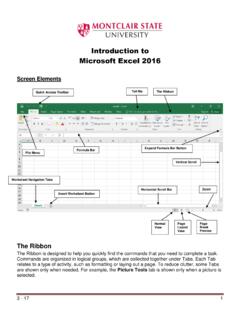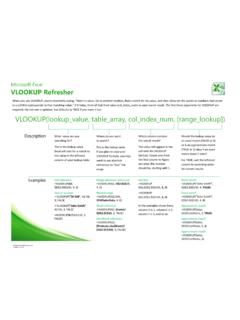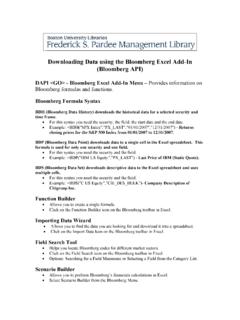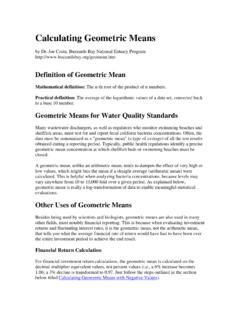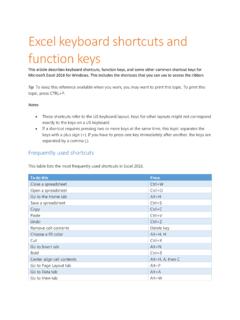Transcription of Microsoft Excel Manual - Administration and Finance
1 1 Version 1 10/20/2015 Training, Evaluation & System Support Microsoft Excel Manual Companion Manuals: Commerce Manager Manual Purpose and Overview The purpose of this Manual is to provide an overview of Microsoft Excel tools and functions which are most useful to improve daily operational efficiency. 2 Table of Contents PURPOSE AND OVERVIEW .. 1 Table of Contents .. 2 SECTION I: WHAT IS Excel ? .. 4 WHAT CAN I DO WITH THIS? .. 4 SECTION II: cells , ROWS, AND COLUMNS .. 4 WHAT IS A CELL? .. 4 WHAT ARE ROWS AND COLUMNS? .. 4 INSERTING ROWS AND COLUMNS .. 4 SECTION III: NAVIGATION .. 6 MOVING BETWEEN cells .. 6 SELECTING MULTIPLE cells .
2 6 SELECTING ENTIRE ROWS AND COLUMNS .. 6 SELECTING MULTIPLE ROWS AND COLUMNS .. 6 SECTION IV: FORMATTING .. 7 cells .. 7 TABLES .. 8 Choosing a Table Style to Create a Table .. 8 Adjust the Table Style .. 9 Creating or Deleting a Custom Table Style .. 9 Removing a Table Style .. 11 Converting a Table to a Range of Data .. 11 Formatting Table Elements .. 11 Pivot Tables .. 12 CONDITIONAL FORMATTING .. 14 Highlight cells Rules .. 14 Greater Than .. 14 Less Than .. 15 Between .. 16 Equal To .. 16 Text That Contains .. 17 A Date Occurring .. 18 Duplicate Values .. 18 Top/Bottom Rules .. 19 Top 10 Items .. 19 Top 10% .. 20 Above Average .. 21 Data Bars.
3 22 Color Scales .. 23 New 24 Clear Rules .. 25 Manage Rules .. 26 SECTION V: SEPARATING TEXT WITHIN A CELL .. 27 SECTION VI: SORTING .. 28 ALPHABETICAL .. 28 NUMERICALLY .. 29 MULTI-LEVEL SORTING .. 29 SORTING BY CELL COLOR .. 31 3 SECTION VII: FILTERS .. 34 SECTION VIII: FUNCTIONS AND FORMULAS .. 36 BASIC FUNCTIONS/FORMULAS .. 36 Sums .. 36 Subtotaling .. 37 One Level Subtotals .. 37 Nested Level Subtotals .. 39 Removing Subtotals .. 42 Average .. 42 Count Numbers .. 43 Maximum and Minimum .. 44 4 SECTION I: What is Excel ? Microsoft Excel is a spreadsheet application that is commonly used for a variety of uses. At its core, Excel is a table consisting of rows and columns.
4 Excel is composed of rows and columns and uses a spreadsheet to display data. Features include: calculation, graphing tools, pivot tables, and a macro programming language called Visual Basic for Applications. What can I do with this? The data within a table can be sorted by any column, which means that the rows can be ordered by last name or first name alphabetically, by the ID number ascending or descending, by the amount paid ascending or descending, or by the date. You can also filter the data in the table to have only specific values show. SECTION II: cells , Rows, and Columns What is a cell? A cell, outlined in green below, is an individual block within a table in which you can enter values, such as words or numbers.
5 What are rows and columns? Rows, outlined in red below, are a horizontal group of cells . Columns, outlined in blue below, are a vertical group of cells . Inserting rows and columns To Add a Row: 1. Select the entire row below where you want to add the new row. This is a row This is a column This is a cell 5 2. Right click, select Insert. To Add a Column 1. Select the column to the right of where you want to add the new column 2. Right click, select Insert. 6 Section III: Navigation Navigating through your spreadsheet doesn t have to be difficult. Using some very simple keystrokes, you can move from one end of your spreadsheet to the other faster than using the scroll bar.
6 Moving Between cells Use the arrow keys on your keyboard to move from one cell to another Use the Tab key to move horizontally to the right. Hold the Shift key and press the Tab key to move horizontally to the left. Use the Enter key to move vertically downward. Hold the Shift key and press the Enter key to move vertically upwards. Selecting Multiple cells To select a range of data: 1. Select the first cell in the data range. 2. Hold the Shift key. 3. Select the last cell in the data range. OR Select the beginning range of data, drag the cursor to select the range of data Selecting Entire Rows and Columns Excel organizes a data sheet by numbering the rows and lettering the columns.
7 To select an entire row: Select the number of the row To select an entire column: Select the letter of the column. Selecting Multiple Rows and Columns To select multiple rows or columns 1. Select the entire first row 2. Hold the Shift Key 3. Select the entire last row of the range of data 7 SECTION IV: Formatting Formatting in Excel allows you to change the appearance of cells or the appearance of the spreadsheet as a whole. cells Formatting cells allow you to change the appearance of the value within the cell without changing the value, such as converting number into a currency or percentage value. To Format a Cell: 1. Select the cell or cells to format 2.
8 Right click and select Format cells . The Format cells dialogue box will appear 8 To convert a numeric value into an accounting value: Select Accounting from the list of Categories. Click Ok. Tables A table is a way of formatting data so that data may be sorted. Tables also display rows in alternating colors to make the data easier to read. Choosing a Table Style to Create a Table To Choose a Table Style: 1. Select the range of cells to include in the table. 2. Choose Table located on the Insert tab. 9 The Create Table dialogue box will appear. If you selected a range of data to include in the table, the table contents will already be populated in the Where is the data for you table field.
9 To include headers in the table, select the My Table has Headers checkbox. To Create a Table from the Home Tab: 1. Select the range of cells to include in the table. 2. Select Format as Table. 3. Follow the steps listed above to create a table. Adjust the Table Style Select the table, and choose the Table Style located on the Design tab. Creating or Deleting a Custom Table Style To Create a Custom Table: 1. Select your data 2. Choose Format as Table. 10 3. Select New Table Style at the bottom of the dropdown menu. The New Table Quick Style dialogue box will appear. 4. Select any of the table elements to format the table as desired.
10 The Preview box allows you to view the table before completing formatting changes. Select OK to apply the table to your data. To Set this Table as a Default Table: 1. Select the Set as default table quick style for this document option To Delete a Custom Style: 1. Select Format as Table. 2. Find the custom style located within the Custom section 3. Right click on the style, select Delete. 11 Removing a Table Style To Remove a Table Style from and Existing Table: 1. Select the contents of the table. 2. Choose the More button. 3. Choose Clear. This will clear the table style but the data will still remain in a table format. Converting a Table to a Range of Data To Convert an Existing Table to a Range of Data: 1.
